Sunwayman is rapidly becoming a big name in the flashlight business, and they are known for their ability to combine function with style in a consistently pleasing way. The V10 series (V10R, V10A, V10R Ti, V10R AE, V10R Ti+,...) has been a huge hit, and the V10R has become the favorite EDC of many flashaholics. The V11R Révolution is an update to that well-loved light, and Sunwayman has responded to many of the requests that their customers have been making. This includes, most notably: a brighter max, better grip on the control ring, brightness indicator on control ring, and an aluminum AA extender.
Thanks to Sunwayman for supplying the V11R for review.
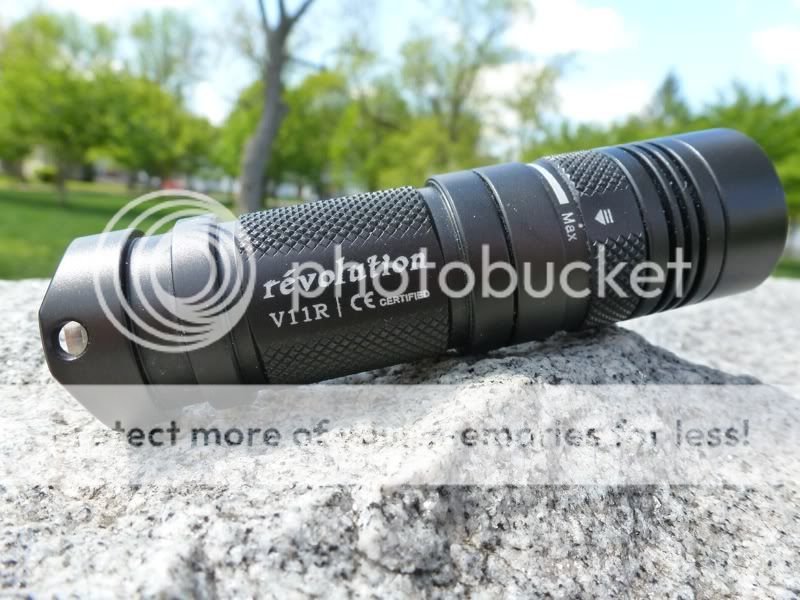
I'll be reviewing the V11R in two sections: first, I'll discuss the light objectively (the facts about the light itself), then I'll discuss the light subjectively (my impressions about the light's performance when used for specific applications). This light is made in the form of a powerful, wide-range EDC, so I'll be reviewing it as such. If you have any other specific applications you'd like the light tested for, let me know and I'll see what I can do.
If you're in a hurry, here's a five minute video review of the V11R.
Objective
Here are the specs on the V11R:
--------
from sunwayman.com:
Features
● CREE XM-L U2 LED, with a lifetime of up to 50,000 hours;
● Digital Sensor Magnetic Control system, Infinite Variable Output Switch- slightly twist the Rotator Ring from left to right for Min to Max output.
Turbo Mode: 500 Lumens (uses one 16340 battery to drive, runtime 25min; CAUTION: Do not run the light continuously at turbo mode for more than 5 minutes.)
Max: 190 Lumens (1.5hrs)
Min: 1 Lumen (35hrs)
● Constant current circuit, constant output
● Effective range of 130 meters
● Uses one single CR123A Lithium battery or RCR123A, 16340 battery
● Working voltage: 0.9~4.2V
● High quality OP reflector maintains great throw distance and spread with an ideal beam pattern
● Dimensions: 84mm (length) x 23mm (head diameter)
● Weight: 49g(battery excluded)
● Aerospace-grade aluminum alloy
● Military Specification Type III- hard anodized body
● Waterproof, in accordance with IPX-8 standard
● Ultra-clear tempered glass lens resists scratches and impacts
● Tactical forward click switch with momentary on
● Tail stand capable- can be used as a candle
● Accessories: Clip, O-ring, lanyard, holster
--------
Packaging
The V11R comes in Sunwayman's standard cardboard box with plastic viewing window showcasing the light.
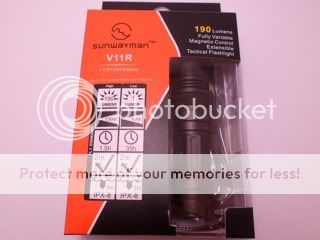
The box contains the light, accessories, user's manual, and warranty card.
Construction Quality
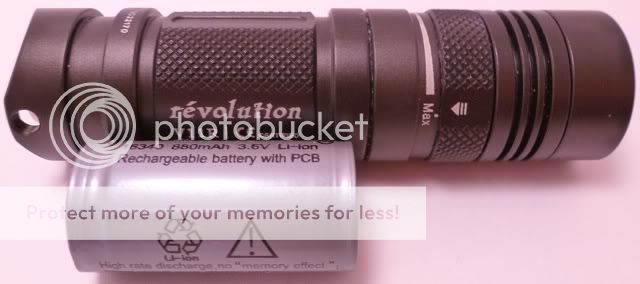
The V11R runs off of one CR123 primary or one 16340 lithium ion battery. It's roughly twice the length, and only slightly wider than the battery.
Let's start at the head and work back.
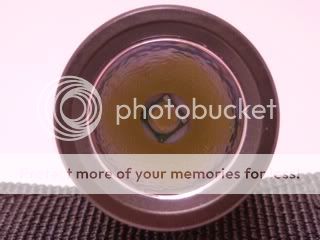
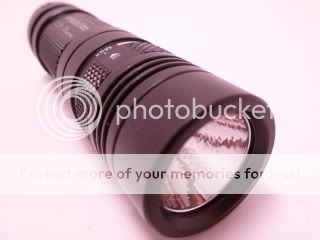
The V11R uses the top-of-the-line Cree XM-L LED emitter, with a U2 bin (the brightest, most efficient bin currently available as of 4/9/12). The LED is well centered in the reflector, for an even beam. The reflector has a light "orange peel" (OP) texture that helps smooth out the beam of the light. This is good for a floody-style light, but slightly decreases the throwing distance of the light. The lens is recessed a few millimeters behind the bezel, to help protect it from scratches and impacts.
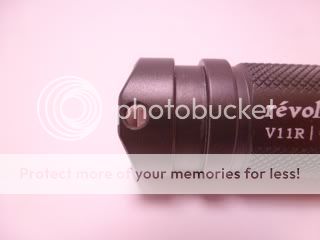
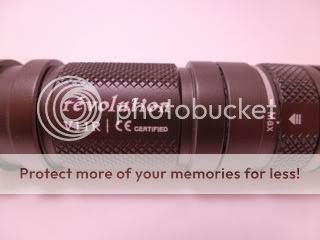
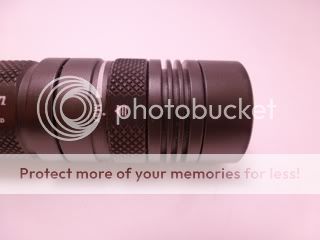
The head has two cooling fins to help move heat from the head into the air around. When using 1x16340 lithium ion, the V11R will have a very high output, which means a lot of heat, in a small space. This means it's very important to hold it in your hand (to help absorb the heat), and SWM recommends not to run it on Max for more than 5 minutes at a time to prevent damage to the emitter. When using 1xCR123, heat should not be an issue.
Behind the cooling fins is the control ring. This is one of the big updates from the V10R. The new control ring has light knurling all around for better grip, and is labeled with a gradient from "Min" to "Max" and an arrow to indicate the current brightness setting. You can adjust the brightness setting either with the light on or off. The V11R control ring uses a much thinner lubricant than the ring on the V10R, so it turns much easier. This means it's possible to adjust the brightness with a single finger, but it's also a little more likely to change the brightness setting while in your pocket. However, it is not going to turn on in your pocket, and if the control ring moves, you'll know because of the labels.
Light knurling has been added to the body of the light as well, giving it better grip than the V10R, at the sacrifice of a little style. The tail is one piece with the body.
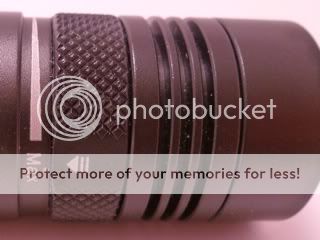

Here's some close shots of the control ring, you can see the Max and Min labels, along with the arrow indicator on the ring.

As you can see, the knurling patter is small and tight, and the sharp points have been taken off to keep the V11R from ripping up your pocket.

This shot shows the profile of the head. The control ring is on the same level as the rest of the head, with the labeled portion having a slightly smaller diameter.



The body has four areas without knurling. One has the model name (V11R révolution), another has the sunwayman name and logo, and two are blank with ovals engraved for style and grip.
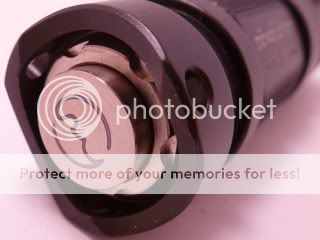
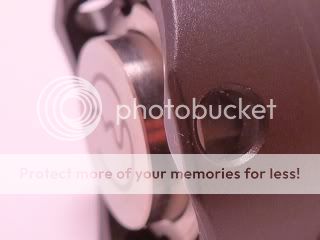
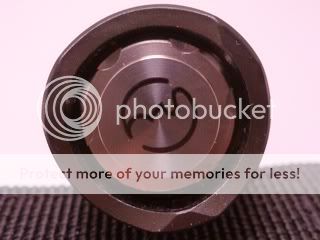
The tail has a cutout pattern with three raised and three lowered portions. Each raised portion has a hole for a lanyard. The crenellations extend just beyond the end of the switch, so the V11R can do a stable tail stand.
Another big difference from the V10R is the metal switch cover replacing the rubber one. This metal switch has the SWM logo printed on it, and has a very stylish look. My review sample has a stiff, almost gritty feel to the switch, that seems to match reports of other users. If the switch is not pressed directly down, it will some times catch and not activate the light. This is a mechanical forward clicky switch, which means you can press it halfway down for momentary on, or all the way down to click into constant on.
UPDATE: (4/17/12) Sunwayman has updated their website to state that the V11R will now come with both the metal switch cover and rubber switch cover as options, so you can choose looks or feel. The rubber switch cover will give the switch the same feel as the V10R (and other models). I've already swapped in a rubber switch cover from another SWM light I don't use often, and I've posted pictures here.
Time to take the light apart.

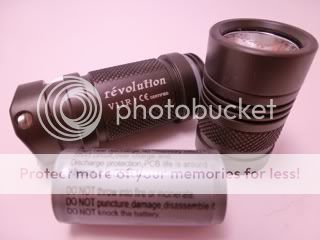
Well, that's pretty exciting. The V11R comes apart into two pieces (without the use of tools): head and body.
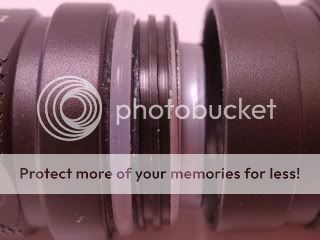
The threads are clean, square, thick, and anodized. This means they should last a long time. Also, the anodization allows a "lock-out" mode, which prevents the light from turning on even when the switch is pressed (good for storage or travel). They feel smooth when you screw/unscrew them. However, the threaded portion is very short, so be aware that it doesn't take very many turns to unscrew the light.
A clear o-ring is included to give the light it's waterproofness. You can see the results of my submersion test in the "performance" section.
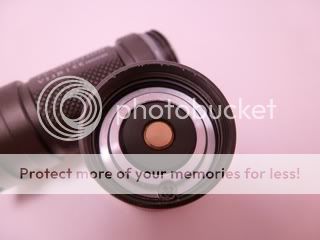
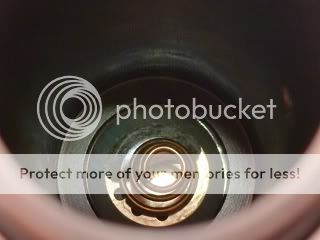
The positive battery terminal connects with this area in the head of the light, and the negative battery terminal connects with this spring in the tail. The spring is short and pretty stiff, and it will help prevent damage from impact.

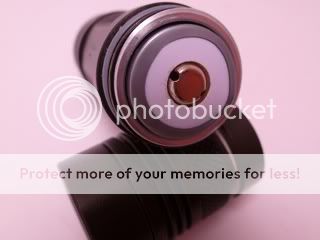
The wall of the body is plenty thick, giving the V11R a good sturdy feel. The battery, when inserted, just barely reaches beyond then end of the body. With the stiff spring and short threaded section of the body, it sometimes requires a steady hand to screw the head back on after a battery change.
Accessories
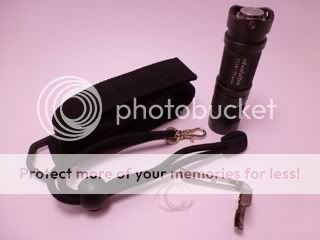
The V11R comes with a holster, lanyard, clip, and two spare o-rings.
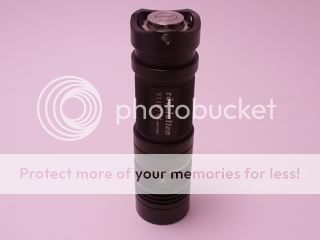
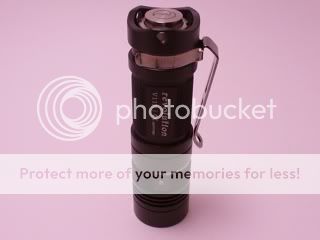
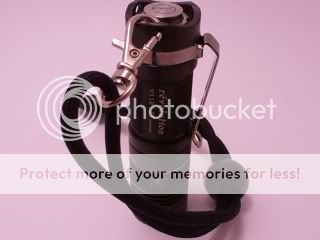
Progression of accessories. The clip attaches just above the body (it requires significant force to take on and off) and the lanyard clips into any of the three holes on the tail. The lanyard is the standard lanyard SWM includes with most of their lights, including an adjuster bead and crab claw.
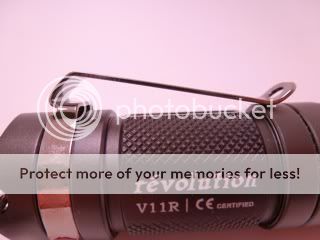
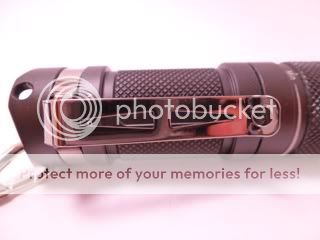
The clip on the V11R is slightly changed from that on the V10R. Overall, it feels sturdier. It is thicker where it connects to the body than the V10R clip, it sticks out a little farther from the body, and it does not extend to the rear of the light (no "deep carry"). Once on, friction holds the clip pretty well in place, but a significant amount of force can cause it to rotate around the body.

From behind, you can see there is no real way to attach the lanyard that will allow a tail stand, and the clip pokes out from the body just a little on the ends. (It was a common practice with the V10R to file off these small protrusions on the clip.)
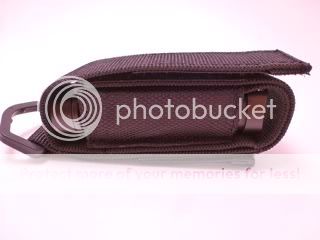
The holster is the standard SWM holster, with an attachment loop, velcro flap and belt attachment, and small "sunwayman" tag on one side.
User Interface
The UI on the V11R is very simple. The switch at the tail turns the light on and off, and the rotating ring controls the brightness. The brightness can be changed while the light is on, or can be pre-set to the desired level while the light is off.
An update from the V10R, is that the ring is much easier to turn (due to the knurling and thinner lubrication). So, it no longer requires two fingers to turn the ring.
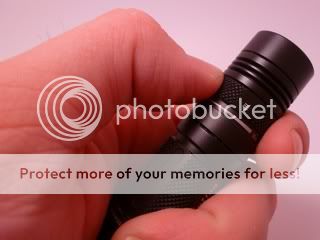
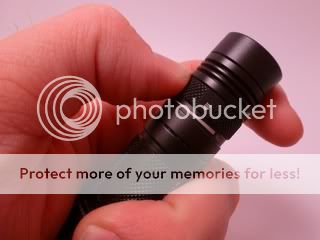
LEFT: Most V10R users will likely have adapted to this grip to control the V10R.
RIGHT: On the V11R, you can easily use this grip if you desire.
Below is a one-minute video of the user interface.
Action Shots
Light in Hand

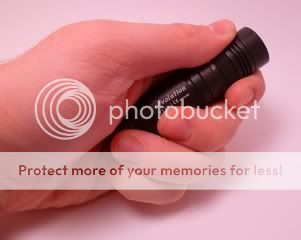
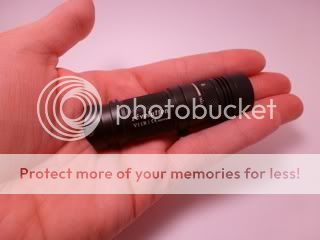
(note: my hands are slightly larger than average)
Head-On
(ISO 160, f/3.3, 1/40")
Min
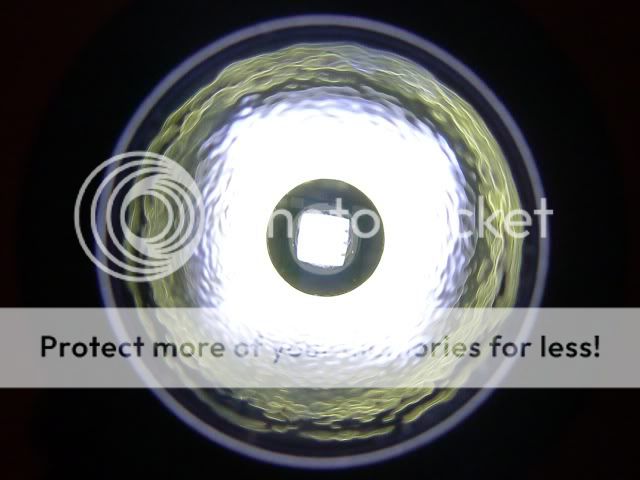
White Wall
(ISO 100, f/3.3, 1/25)
Max

This is not an accurate representation of the tint (to my eyes), see the BeamSlice for a better idea of tint. This picture illustrates the beam pattern. Due to the OP texture, the beam is pretty smooth, though if I look hard I can see a few rings.
BeamSlice
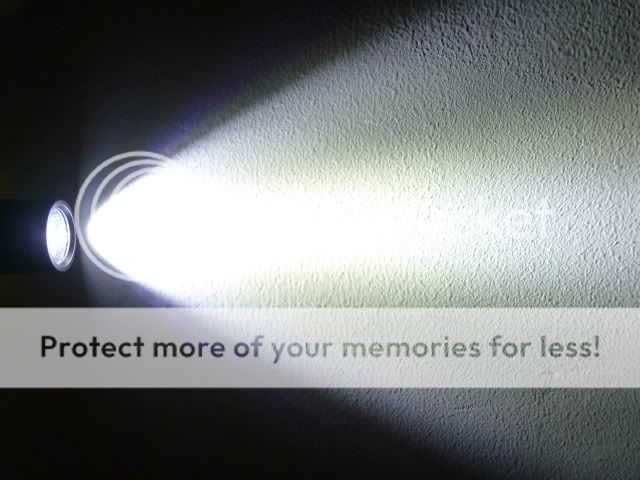
The V11R has a very wide beam, making it more of a flood-type light, and not so much for throw (though the throw isn't bad due to the sheer output). Due to the reflector design, the cooler tints are thrown to the outer edges, and the warmer tints tend to end up in the middle. This is a "cool white" binned emitter, but as you can see, the only bluish bit is on the very edge, and is not noticeable in normal use.
Indoor Shots
Outdoor Shots
(ISO 100, f/3.3, 1")






Performance
Submersion: Sunwayman claims an IPX-8 rating on the V11R, which means it should be able to handle continuous immersion below 1 meter of water. I submersed it under about a foot of water for 15 minutes, turning it on and off and rotating the control ring periodically. At the end of that time, no water had entered the body of the light. A bit of water did enter the other part of the switch housing, which did not affect operation of the light now, but if the water enters and is not removed (it's forced out when I push the button) I wonder if it might cause rust inside the switch mechanism.
Heat: Using 1xCR123, running on Max for any period of time causes no heat issues. Using 1x16340, running on Max quickly warms up the V11R, and SWM recommends not using it continuously for more than 5 minutes. I'd agree that after that amount of time, the light is hot, and should be allowed to cool down.
Impact: I dropped the V11R several times onto different surfaces (carpet, tile, grass, packed dirt) from heights of 1 to 2 meters, and I can find no damage to the appearance or performance of the light.
Reverse Polarity Protection: None, as far as I know. Be sure to put the battery in with the positive terminal facing the head, and the negative terminal facing the spring in the tail.
Over-Discharge Protection: None, as far as I know. For normal use, you're going to want to use ICR protected lithium ion cells. You might get increased output using unprotected IMR cells, but if you choose to, be sure to recharge your cells often.
PWM: I can find no audible or visible trace of pulse-width modulation on any brightness setting.
Low Voltage Warning: For most battery types, the V11R will do a low voltage warning by flashing off briefly. As the voltage continues to drop, the flashes become more frequent and the brightness decreases, until the battery dies. When you see the low voltage warning flash, you can dial down the brightness a bit and the light will return to a constant-on state, until the voltage drops enough to trigger the warning for the lower setting. This does not happen when using protected AW ICR batteries, but it does happen when using protected Ultrafire ICR batteries. My guess is that the protection circuit on the AW cells has a higher threshold than the low voltage warning on the V11R, so the protection circuit on the battery shuts the cell down before the low voltage warning on the light is activated.
Current Draw
1x16340 AW Protected ICR
Max: 1.88 A
Min: 13.5 mA
Output and Runtime
Note: The vertical axis of these charts represents a relative brightness measurement using a home made light box. The horizontal axis is time in hours:minutes:seconds. Runtimes are stated in hours:minutes:seconds.
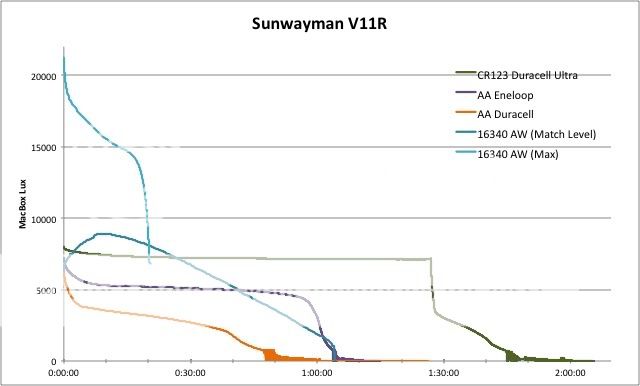
CR123 Duracell Ultra
Time Regulated: 1:26:57
Time to 50%: 1:27:38
Time Until Low Voltage Flash: 1:44:48
Time Flashing: 0:20:44
AA Duracell
Time to 50%: 0:16:59
Time Until Low Voltage Flash: 0:47:44
Time Flashing: 0:38:41
note: the time to 50% is so low because it starts much brighter than the output it levels off at.
AA Eneloop
Time to 50%: 0:59:02
Time Until Low Voltage Flash: 1:03:41
Time Flashing: 0:11:11
16340 AW (Matching Level)
Time to 50%: 0:52:37
Full Runtime: 1:04:22
note: no low voltage warning with AW lithium ions, though I do see a low voltage warning when using Ultrafire lithium ions.
16340 AW (Max)
Time to 50%: 0:19:34
Full Run Time: 0:20:41
note: no low voltage warning with AW lithium ions, though I do see a low voltage warning when using Ultrafire lithium ions.
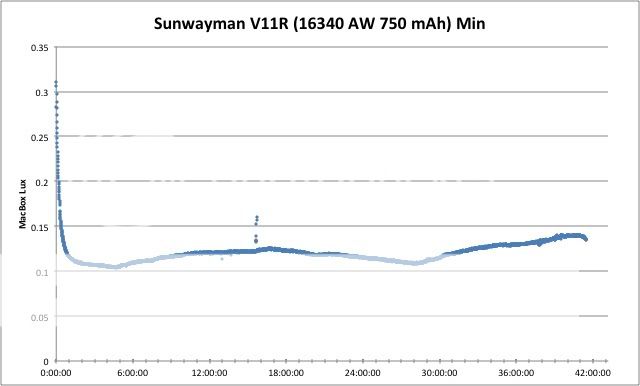
16340 AW (Min)
Time Regulated: 41:28:57
Time to 50%: 0:26:33
Full Run time: 41:28:57
note: no low voltage warning with AW lithium ions, though I do see a low voltage warning when using Ultrafire lithium ions.
Spectral Analysis
All light that we see as white is actually made up of several colors. Using a homemade spectrometer, I can evaluate the spectral output of a light. This graph shows the relative intensity of different wavelengths. The more intense a certain color band is, the more the light will appear to be tinted that color.
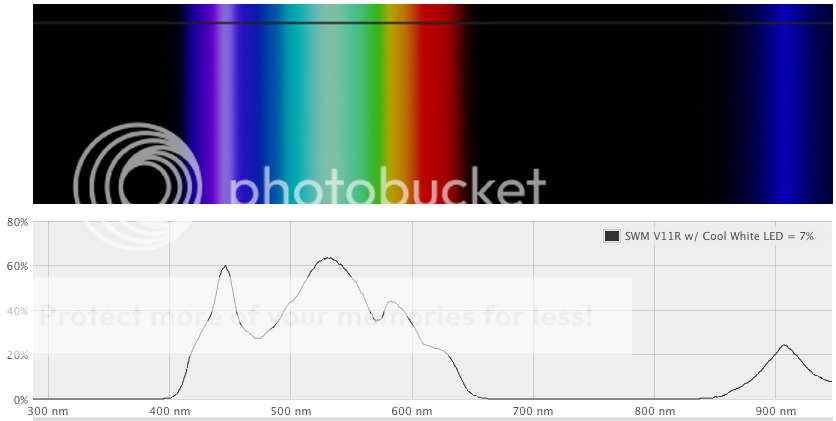
Subjective Review
General
Quick break down:
+Infinitely variable by control ring - wonderful UI
+Control ring much easier to grip
+Control ring much easier to turn
+Brightness setting labels
+Perfect size
+Wide rande of output
+Many batter options
+Al extender available
+Smooth beam
+Looks incredibly good
+Water and impact resistant
+Low voltage warning
-Control ring too thin
-Metal switch cover is rough
-No way for stable tail stand with lanyard
-Lower low would be great
The V11R is a great step forward from the V10R. The use of the U2 binned XM-L over the T6 gives a decent increase in output and efficiency, but may favorite update is the control ring. At first it felt a little weird with how easy it was to turn, compared to the V10R I was used to. I was worried about it changing brightness settings in my pocket, but after carrying it I've realized I don't care if it does or not. This is not a "tactical" light, it's a general use, all-purpose light. With the markings indicating the brightness level, I don't care what level it's set to when I pick it up, because I always know what's going to happen when I turn it on. The only thing I would have SWM do differently with the control ring is use the space where the labels are printed to make the control ring wider, and print the labels up on the body.
There are only two real steps backwards that I've found. 1) The switch, though it looks awesome, has a rough feel, and is not nearly as pleasant to use as the rubber switch on the V10R. I have this same problem with the switch on my Ti2. After doing the submersion test on the V10R, I found that the water helped it loosen up a bit and move a little smoother, so I have high hopes that some lubrication will go a long way here. If that doesn't work, I'll try to replace the metal switch with a rubber one, though it will be a shame to loose the good looks. 2) The tail design with the three crenelations and three lanyard holes makes it even harder to do a tail stand with lanyard than with the V10R, because the holes are farther apart. Here's what I mean:
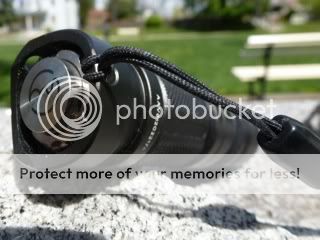
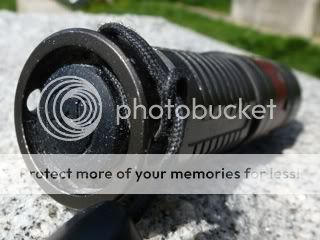
With the V10R (right) I was able to use a simple lanyard from a Xeno E03 going through two holes to allow a very stable tail stand. With the wider spacing between holes on the V11R (left) that is no longer possible. I'm going to experiment with some loose cord to see if I can make a suitable lanyard. As of now, it can tail stand a bit, but it's not very stable.
The minimum brightness I know is a big deal for a lot of people, and it's one of the reasons my V10R has been my EDC for so long. Here's a shot of the V11R and V10R AE side by side on Min.
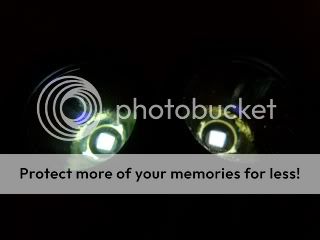
The V11R (left) is slightly brighter than the V10R AE (right). I expected this because my V10R has a neutral emitter with (I think) a T5 bin, which is less efficient than the U2 bin. In practice, I've found that using them on Min around the house at night, the outputs are pretty close to the same, though I can tell that the V11R is slightly brighter.
A note on the UI: the control ring is such a pleasure to use. Once you use this, you'll never want to use another click-through-a-sequence-of-modes UI. At this time, the magnetic control ring does require a small amount of overhead current, so at low outputs you'll see less efficiency than a light with no control ring at a similar output. However, for me, the ease of use is definitely worth it. This isn't going to be the light to set on low as a candle in a long-term emergency situation. But it's going to get you around a dark area without being noticed, with the option to move quickly to any output you need as quickly as you need to, without passing through any output level you don't want (which is huge).
The low voltage warning is great. When I turn it up to max and the light starts to flash, I dial down the brightness a bit and still have plenty of constant light to easily locate a replacement battery. A fun idea for the future: a capacitor built into the head that allows you some very small output for a short time while you perform the actual battery change. That's the only thing I can think of to improve this low voltage feature. :thumbsup:
Really, like with the V10R, I can't say enough good things about this light. It's not perfect, but it's getting closer, and I'm excited to see what SWM has in store for the future. The small size with wide output range is great, and if you don't have a light that can do that, you need one. This is a great choice.
EDC
There's not too much to say here that hasn't already been said. As an every-day carry, the V11R will be a great choice for almost anyone, and it will be replacing my V10R as my EDC. I can't say how great it is to be able to move around a dark area constant adjusting my light level to whatever I need. I've tried to go back to EDC'ing other styles of discrete output level lights, and it just feels awkward now. There are definitely uses for lights with discrete output levels, but I wouldn't ever want to be without a light like this one. It's also very important to me that my EDC can use lithium ion cells regularly for their high power, but also use common cells (AA or AAA) in an emergency, so I also have the AA extender with me in my bag at all times.
The only reason to hold back on the V11R is possibly the switch, and I hope to have some resolution for that soon.
Long Term Impressions
I'll fill this part in after carrying the light for a while. If nothing get's added here, either I find nothing else worth noting about the light, or I end up not using it often. I probably won't be able to do much for long term impressions, because the light is only loaned to me for a limited period of time.
4/17/12: Sunwayman has updated their website to state that the V11R will now come with both the metal switch cover and rubber switch cover as options, so you can choose looks or feel. The rubber switch cover will give the switch the same feel as the V10R (and other models). I've already swapped in a rubber switch cover from another SWM light I don't use often, and I've posted pictures here.
4/21/12: After EDC'ing the V11R for about 2 weeks, I went back to try to use my V10R, and found the ring on the V10R to be incredibly hard to turn. I didn't realize how quickly I would get used to, and come to like, the better grip and less viscous grease on the V11R control ring.
Also, while doing the outdoor shots, I took some fun ones as well. Here's one with a half minute exposure, the V11R lying in the grass:
(ISO 100, f/3.3, 30")
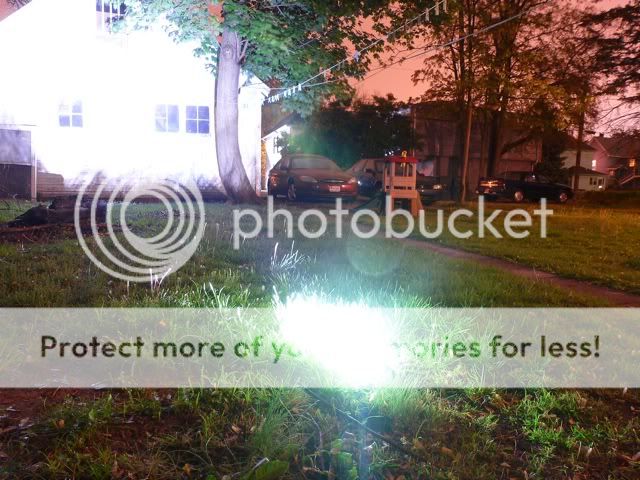
5/12/12: I recently picked up a warm High CRI V11R, and thought it would be worth putting a few notes about it here. First, it shipped with the rubber switch boot installed and the metal switch cover in a small plastic bag, where it will stay :thumbsup:. Second, the ring on my V11R HCRI seems to have a different sort of lubricant. On the standard V11R there is very little resistance on the ring, and on the HCRI version the ring is much harder to turn. After working it back and forth a few times it loosens up for a time, but then stiffens if I don't use it again for the rest of the day. Similar behavior has been reported by several members who got an HCRI version. The lubrication seems to be thicker the slower you turn it, and thinner when you turn it faster, and the difference is very noticeable. I don't know if this is limited to the HCRI run, or if all of the V11R's have this feature, I haven't heard any comments about it on the standard version. This has some advantages and disadvantages. I like that the ring is much less likely to turn in your pocket, and that you can make small adjustments more easily. However, it can get really stiff if not used for a while. Several buyers of the HCRI version reported the ring being extremely stuck when they first received it, and some even having to use tools to get it unstuck. After getting it unstuck, the operation is as I have described, but I worry about what might happen if you store the light and don't use it for a while.
Also, I have an important note on using the V11R AA extender: Due to the high resistance of the control ring, I find that when I use the AA extender with my HCRI version, trying to turn the brightness up while holding the body instead of the extender will actually unscrew the extender! This means that when I was out in my garage last night, I heard something scuffling in the corner, went to quickly turn up to max brightness, and the extender unscrewed turning my V11R off instead! The creature escaped. This isn't acceptable, so, I'll be changing the lubrication on my V11R HCRI, per some suggestions in some other threads on the subject. This doesn't seem to be an issue with the standard V11R (at least on my sample) because the resistance on the ring is so low.
And, here are some pictures!
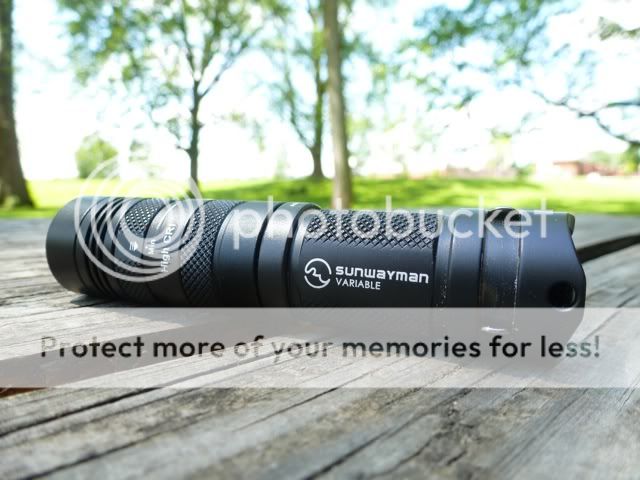
Left: V11R (cool) Mid: V10R Anniversary Edition (neutral) Right: V11R HCRI (warm)
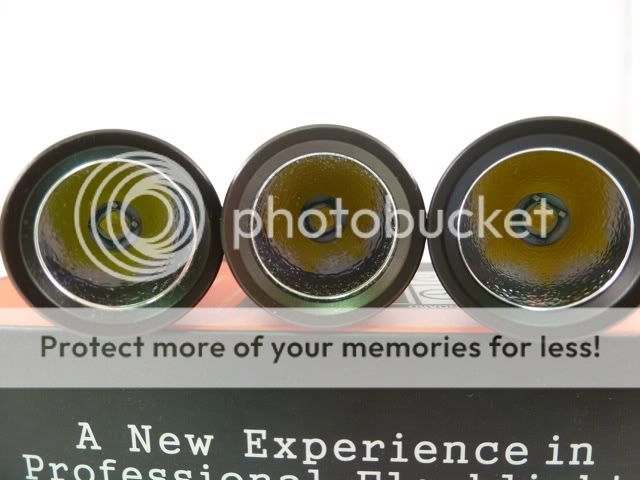


Thanks to Sunwayman for supplying the V11R for review.

I'll be reviewing the V11R in two sections: first, I'll discuss the light objectively (the facts about the light itself), then I'll discuss the light subjectively (my impressions about the light's performance when used for specific applications). This light is made in the form of a powerful, wide-range EDC, so I'll be reviewing it as such. If you have any other specific applications you'd like the light tested for, let me know and I'll see what I can do.
If you're in a hurry, here's a five minute video review of the V11R.
Objective
Here are the specs on the V11R:
--------
from sunwayman.com:
Features
● CREE XM-L U2 LED, with a lifetime of up to 50,000 hours;
● Digital Sensor Magnetic Control system, Infinite Variable Output Switch- slightly twist the Rotator Ring from left to right for Min to Max output.
Turbo Mode: 500 Lumens (uses one 16340 battery to drive, runtime 25min; CAUTION: Do not run the light continuously at turbo mode for more than 5 minutes.)
Max: 190 Lumens (1.5hrs)
Min: 1 Lumen (35hrs)
● Constant current circuit, constant output
● Effective range of 130 meters
● Uses one single CR123A Lithium battery or RCR123A, 16340 battery
● Working voltage: 0.9~4.2V
● High quality OP reflector maintains great throw distance and spread with an ideal beam pattern
● Dimensions: 84mm (length) x 23mm (head diameter)
● Weight: 49g(battery excluded)
● Aerospace-grade aluminum alloy
● Military Specification Type III- hard anodized body
● Waterproof, in accordance with IPX-8 standard
● Ultra-clear tempered glass lens resists scratches and impacts
● Tactical forward click switch with momentary on
● Tail stand capable- can be used as a candle
● Accessories: Clip, O-ring, lanyard, holster
--------
Packaging
The V11R comes in Sunwayman's standard cardboard box with plastic viewing window showcasing the light.

The box contains the light, accessories, user's manual, and warranty card.
Construction Quality

The V11R runs off of one CR123 primary or one 16340 lithium ion battery. It's roughly twice the length, and only slightly wider than the battery.
Let's start at the head and work back.


The V11R uses the top-of-the-line Cree XM-L LED emitter, with a U2 bin (the brightest, most efficient bin currently available as of 4/9/12). The LED is well centered in the reflector, for an even beam. The reflector has a light "orange peel" (OP) texture that helps smooth out the beam of the light. This is good for a floody-style light, but slightly decreases the throwing distance of the light. The lens is recessed a few millimeters behind the bezel, to help protect it from scratches and impacts.



The head has two cooling fins to help move heat from the head into the air around. When using 1x16340 lithium ion, the V11R will have a very high output, which means a lot of heat, in a small space. This means it's very important to hold it in your hand (to help absorb the heat), and SWM recommends not to run it on Max for more than 5 minutes at a time to prevent damage to the emitter. When using 1xCR123, heat should not be an issue.
Behind the cooling fins is the control ring. This is one of the big updates from the V10R. The new control ring has light knurling all around for better grip, and is labeled with a gradient from "Min" to "Max" and an arrow to indicate the current brightness setting. You can adjust the brightness setting either with the light on or off. The V11R control ring uses a much thinner lubricant than the ring on the V10R, so it turns much easier. This means it's possible to adjust the brightness with a single finger, but it's also a little more likely to change the brightness setting while in your pocket. However, it is not going to turn on in your pocket, and if the control ring moves, you'll know because of the labels.
Light knurling has been added to the body of the light as well, giving it better grip than the V10R, at the sacrifice of a little style. The tail is one piece with the body.


Here's some close shots of the control ring, you can see the Max and Min labels, along with the arrow indicator on the ring.

As you can see, the knurling patter is small and tight, and the sharp points have been taken off to keep the V11R from ripping up your pocket.

This shot shows the profile of the head. The control ring is on the same level as the rest of the head, with the labeled portion having a slightly smaller diameter.



The body has four areas without knurling. One has the model name (V11R révolution), another has the sunwayman name and logo, and two are blank with ovals engraved for style and grip.



The tail has a cutout pattern with three raised and three lowered portions. Each raised portion has a hole for a lanyard. The crenellations extend just beyond the end of the switch, so the V11R can do a stable tail stand.
Another big difference from the V10R is the metal switch cover replacing the rubber one. This metal switch has the SWM logo printed on it, and has a very stylish look. My review sample has a stiff, almost gritty feel to the switch, that seems to match reports of other users. If the switch is not pressed directly down, it will some times catch and not activate the light. This is a mechanical forward clicky switch, which means you can press it halfway down for momentary on, or all the way down to click into constant on.
UPDATE: (4/17/12) Sunwayman has updated their website to state that the V11R will now come with both the metal switch cover and rubber switch cover as options, so you can choose looks or feel. The rubber switch cover will give the switch the same feel as the V10R (and other models). I've already swapped in a rubber switch cover from another SWM light I don't use often, and I've posted pictures here.
Time to take the light apart.


Well, that's pretty exciting. The V11R comes apart into two pieces (without the use of tools): head and body.

The threads are clean, square, thick, and anodized. This means they should last a long time. Also, the anodization allows a "lock-out" mode, which prevents the light from turning on even when the switch is pressed (good for storage or travel). They feel smooth when you screw/unscrew them. However, the threaded portion is very short, so be aware that it doesn't take very many turns to unscrew the light.
A clear o-ring is included to give the light it's waterproofness. You can see the results of my submersion test in the "performance" section.


The positive battery terminal connects with this area in the head of the light, and the negative battery terminal connects with this spring in the tail. The spring is short and pretty stiff, and it will help prevent damage from impact.


The wall of the body is plenty thick, giving the V11R a good sturdy feel. The battery, when inserted, just barely reaches beyond then end of the body. With the stiff spring and short threaded section of the body, it sometimes requires a steady hand to screw the head back on after a battery change.
Accessories

The V11R comes with a holster, lanyard, clip, and two spare o-rings.



Progression of accessories. The clip attaches just above the body (it requires significant force to take on and off) and the lanyard clips into any of the three holes on the tail. The lanyard is the standard lanyard SWM includes with most of their lights, including an adjuster bead and crab claw.


The clip on the V11R is slightly changed from that on the V10R. Overall, it feels sturdier. It is thicker where it connects to the body than the V10R clip, it sticks out a little farther from the body, and it does not extend to the rear of the light (no "deep carry"). Once on, friction holds the clip pretty well in place, but a significant amount of force can cause it to rotate around the body.

From behind, you can see there is no real way to attach the lanyard that will allow a tail stand, and the clip pokes out from the body just a little on the ends. (It was a common practice with the V10R to file off these small protrusions on the clip.)

The holster is the standard SWM holster, with an attachment loop, velcro flap and belt attachment, and small "sunwayman" tag on one side.
User Interface
The UI on the V11R is very simple. The switch at the tail turns the light on and off, and the rotating ring controls the brightness. The brightness can be changed while the light is on, or can be pre-set to the desired level while the light is off.
An update from the V10R, is that the ring is much easier to turn (due to the knurling and thinner lubrication). So, it no longer requires two fingers to turn the ring.


LEFT: Most V10R users will likely have adapted to this grip to control the V10R.
RIGHT: On the V11R, you can easily use this grip if you desire.
Below is a one-minute video of the user interface.
Action Shots
Light in Hand



(note: my hands are slightly larger than average)
Head-On
(ISO 160, f/3.3, 1/40")
Min

White Wall
(ISO 100, f/3.3, 1/25)
Max

This is not an accurate representation of the tint (to my eyes), see the BeamSlice for a better idea of tint. This picture illustrates the beam pattern. Due to the OP texture, the beam is pretty smooth, though if I look hard I can see a few rings.
BeamSlice

The V11R has a very wide beam, making it more of a flood-type light, and not so much for throw (though the throw isn't bad due to the sheer output). Due to the reflector design, the cooler tints are thrown to the outer edges, and the warmer tints tend to end up in the middle. This is a "cool white" binned emitter, but as you can see, the only bluish bit is on the very edge, and is not noticeable in normal use.
Indoor Shots
Outdoor Shots
(ISO 100, f/3.3, 1")






Performance
Submersion: Sunwayman claims an IPX-8 rating on the V11R, which means it should be able to handle continuous immersion below 1 meter of water. I submersed it under about a foot of water for 15 minutes, turning it on and off and rotating the control ring periodically. At the end of that time, no water had entered the body of the light. A bit of water did enter the other part of the switch housing, which did not affect operation of the light now, but if the water enters and is not removed (it's forced out when I push the button) I wonder if it might cause rust inside the switch mechanism.
Heat: Using 1xCR123, running on Max for any period of time causes no heat issues. Using 1x16340, running on Max quickly warms up the V11R, and SWM recommends not using it continuously for more than 5 minutes. I'd agree that after that amount of time, the light is hot, and should be allowed to cool down.
Impact: I dropped the V11R several times onto different surfaces (carpet, tile, grass, packed dirt) from heights of 1 to 2 meters, and I can find no damage to the appearance or performance of the light.
Reverse Polarity Protection: None, as far as I know. Be sure to put the battery in with the positive terminal facing the head, and the negative terminal facing the spring in the tail.
Over-Discharge Protection: None, as far as I know. For normal use, you're going to want to use ICR protected lithium ion cells. You might get increased output using unprotected IMR cells, but if you choose to, be sure to recharge your cells often.
PWM: I can find no audible or visible trace of pulse-width modulation on any brightness setting.
Low Voltage Warning: For most battery types, the V11R will do a low voltage warning by flashing off briefly. As the voltage continues to drop, the flashes become more frequent and the brightness decreases, until the battery dies. When you see the low voltage warning flash, you can dial down the brightness a bit and the light will return to a constant-on state, until the voltage drops enough to trigger the warning for the lower setting. This does not happen when using protected AW ICR batteries, but it does happen when using protected Ultrafire ICR batteries. My guess is that the protection circuit on the AW cells has a higher threshold than the low voltage warning on the V11R, so the protection circuit on the battery shuts the cell down before the low voltage warning on the light is activated.
Current Draw
1x16340 AW Protected ICR
Max: 1.88 A
Min: 13.5 mA
Output and Runtime
Note: The vertical axis of these charts represents a relative brightness measurement using a home made light box. The horizontal axis is time in hours:minutes:seconds. Runtimes are stated in hours:minutes:seconds.

CR123 Duracell Ultra
Time Regulated: 1:26:57
Time to 50%: 1:27:38
Time Until Low Voltage Flash: 1:44:48
Time Flashing: 0:20:44
AA Duracell
Time to 50%: 0:16:59
Time Until Low Voltage Flash: 0:47:44
Time Flashing: 0:38:41
note: the time to 50% is so low because it starts much brighter than the output it levels off at.
AA Eneloop
Time to 50%: 0:59:02
Time Until Low Voltage Flash: 1:03:41
Time Flashing: 0:11:11
16340 AW (Matching Level)
Time to 50%: 0:52:37
Full Runtime: 1:04:22
note: no low voltage warning with AW lithium ions, though I do see a low voltage warning when using Ultrafire lithium ions.
16340 AW (Max)
Time to 50%: 0:19:34
Full Run Time: 0:20:41
note: no low voltage warning with AW lithium ions, though I do see a low voltage warning when using Ultrafire lithium ions.

16340 AW (Min)
Time Regulated: 41:28:57
Time to 50%: 0:26:33
Full Run time: 41:28:57
note: no low voltage warning with AW lithium ions, though I do see a low voltage warning when using Ultrafire lithium ions.
Spectral Analysis
All light that we see as white is actually made up of several colors. Using a homemade spectrometer, I can evaluate the spectral output of a light. This graph shows the relative intensity of different wavelengths. The more intense a certain color band is, the more the light will appear to be tinted that color.

Subjective Review
General
Quick break down:
+Infinitely variable by control ring - wonderful UI
+Control ring much easier to grip
+Control ring much easier to turn
+Brightness setting labels
+Perfect size
+Wide rande of output
+Many batter options
+Al extender available
+Smooth beam
+Looks incredibly good
+Water and impact resistant
+Low voltage warning
-Control ring too thin
-Metal switch cover is rough
-No way for stable tail stand with lanyard
-Lower low would be great
The V11R is a great step forward from the V10R. The use of the U2 binned XM-L over the T6 gives a decent increase in output and efficiency, but may favorite update is the control ring. At first it felt a little weird with how easy it was to turn, compared to the V10R I was used to. I was worried about it changing brightness settings in my pocket, but after carrying it I've realized I don't care if it does or not. This is not a "tactical" light, it's a general use, all-purpose light. With the markings indicating the brightness level, I don't care what level it's set to when I pick it up, because I always know what's going to happen when I turn it on. The only thing I would have SWM do differently with the control ring is use the space where the labels are printed to make the control ring wider, and print the labels up on the body.
There are only two real steps backwards that I've found. 1) The switch, though it looks awesome, has a rough feel, and is not nearly as pleasant to use as the rubber switch on the V10R. I have this same problem with the switch on my Ti2. After doing the submersion test on the V10R, I found that the water helped it loosen up a bit and move a little smoother, so I have high hopes that some lubrication will go a long way here. If that doesn't work, I'll try to replace the metal switch with a rubber one, though it will be a shame to loose the good looks. 2) The tail design with the three crenelations and three lanyard holes makes it even harder to do a tail stand with lanyard than with the V10R, because the holes are farther apart. Here's what I mean:


With the V10R (right) I was able to use a simple lanyard from a Xeno E03 going through two holes to allow a very stable tail stand. With the wider spacing between holes on the V11R (left) that is no longer possible. I'm going to experiment with some loose cord to see if I can make a suitable lanyard. As of now, it can tail stand a bit, but it's not very stable.
The minimum brightness I know is a big deal for a lot of people, and it's one of the reasons my V10R has been my EDC for so long. Here's a shot of the V11R and V10R AE side by side on Min.

The V11R (left) is slightly brighter than the V10R AE (right). I expected this because my V10R has a neutral emitter with (I think) a T5 bin, which is less efficient than the U2 bin. In practice, I've found that using them on Min around the house at night, the outputs are pretty close to the same, though I can tell that the V11R is slightly brighter.
A note on the UI: the control ring is such a pleasure to use. Once you use this, you'll never want to use another click-through-a-sequence-of-modes UI. At this time, the magnetic control ring does require a small amount of overhead current, so at low outputs you'll see less efficiency than a light with no control ring at a similar output. However, for me, the ease of use is definitely worth it. This isn't going to be the light to set on low as a candle in a long-term emergency situation. But it's going to get you around a dark area without being noticed, with the option to move quickly to any output you need as quickly as you need to, without passing through any output level you don't want (which is huge).
The low voltage warning is great. When I turn it up to max and the light starts to flash, I dial down the brightness a bit and still have plenty of constant light to easily locate a replacement battery. A fun idea for the future: a capacitor built into the head that allows you some very small output for a short time while you perform the actual battery change. That's the only thing I can think of to improve this low voltage feature. :thumbsup:
Really, like with the V10R, I can't say enough good things about this light. It's not perfect, but it's getting closer, and I'm excited to see what SWM has in store for the future. The small size with wide output range is great, and if you don't have a light that can do that, you need one. This is a great choice.
EDC
There's not too much to say here that hasn't already been said. As an every-day carry, the V11R will be a great choice for almost anyone, and it will be replacing my V10R as my EDC. I can't say how great it is to be able to move around a dark area constant adjusting my light level to whatever I need. I've tried to go back to EDC'ing other styles of discrete output level lights, and it just feels awkward now. There are definitely uses for lights with discrete output levels, but I wouldn't ever want to be without a light like this one. It's also very important to me that my EDC can use lithium ion cells regularly for their high power, but also use common cells (AA or AAA) in an emergency, so I also have the AA extender with me in my bag at all times.
The only reason to hold back on the V11R is possibly the switch, and I hope to have some resolution for that soon.
Long Term Impressions
I'll fill this part in after carrying the light for a while. If nothing get's added here, either I find nothing else worth noting about the light, or I end up not using it often. I probably won't be able to do much for long term impressions, because the light is only loaned to me for a limited period of time.
4/17/12: Sunwayman has updated their website to state that the V11R will now come with both the metal switch cover and rubber switch cover as options, so you can choose looks or feel. The rubber switch cover will give the switch the same feel as the V10R (and other models). I've already swapped in a rubber switch cover from another SWM light I don't use often, and I've posted pictures here.
4/21/12: After EDC'ing the V11R for about 2 weeks, I went back to try to use my V10R, and found the ring on the V10R to be incredibly hard to turn. I didn't realize how quickly I would get used to, and come to like, the better grip and less viscous grease on the V11R control ring.
Also, while doing the outdoor shots, I took some fun ones as well. Here's one with a half minute exposure, the V11R lying in the grass:
(ISO 100, f/3.3, 30")

5/12/12: I recently picked up a warm High CRI V11R, and thought it would be worth putting a few notes about it here. First, it shipped with the rubber switch boot installed and the metal switch cover in a small plastic bag, where it will stay :thumbsup:. Second, the ring on my V11R HCRI seems to have a different sort of lubricant. On the standard V11R there is very little resistance on the ring, and on the HCRI version the ring is much harder to turn. After working it back and forth a few times it loosens up for a time, but then stiffens if I don't use it again for the rest of the day. Similar behavior has been reported by several members who got an HCRI version. The lubrication seems to be thicker the slower you turn it, and thinner when you turn it faster, and the difference is very noticeable. I don't know if this is limited to the HCRI run, or if all of the V11R's have this feature, I haven't heard any comments about it on the standard version. This has some advantages and disadvantages. I like that the ring is much less likely to turn in your pocket, and that you can make small adjustments more easily. However, it can get really stiff if not used for a while. Several buyers of the HCRI version reported the ring being extremely stuck when they first received it, and some even having to use tools to get it unstuck. After getting it unstuck, the operation is as I have described, but I worry about what might happen if you store the light and don't use it for a while.
Also, I have an important note on using the V11R AA extender: Due to the high resistance of the control ring, I find that when I use the AA extender with my HCRI version, trying to turn the brightness up while holding the body instead of the extender will actually unscrew the extender! This means that when I was out in my garage last night, I heard something scuffling in the corner, went to quickly turn up to max brightness, and the extender unscrewed turning my V11R off instead! The creature escaped. This isn't acceptable, so, I'll be changing the lubrication on my V11R HCRI, per some suggestions in some other threads on the subject. This doesn't seem to be an issue with the standard V11R (at least on my sample) because the resistance on the ring is so low.
And, here are some pictures!

Left: V11R (cool) Mid: V10R Anniversary Edition (neutral) Right: V11R HCRI (warm)



Last edited:


